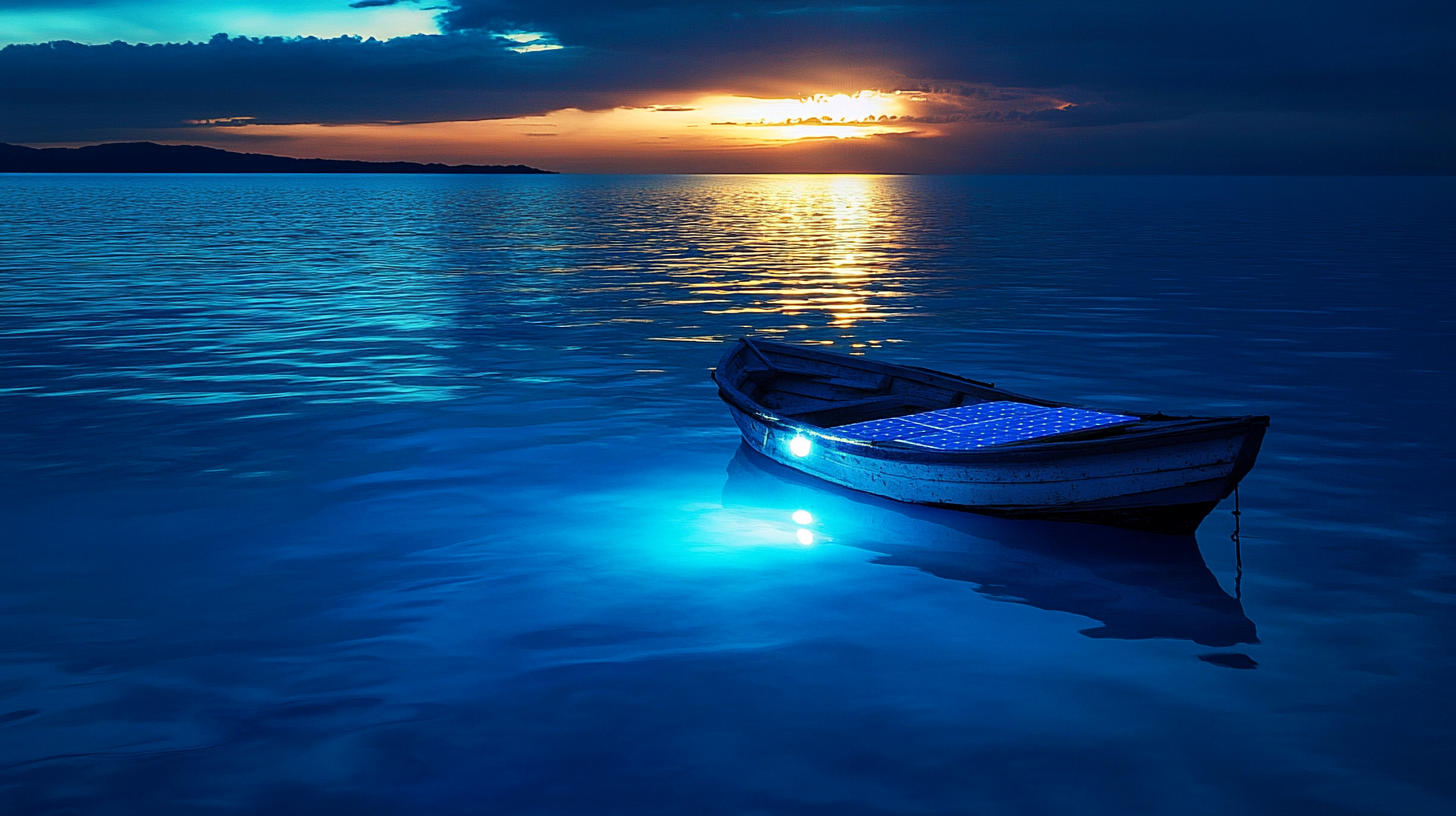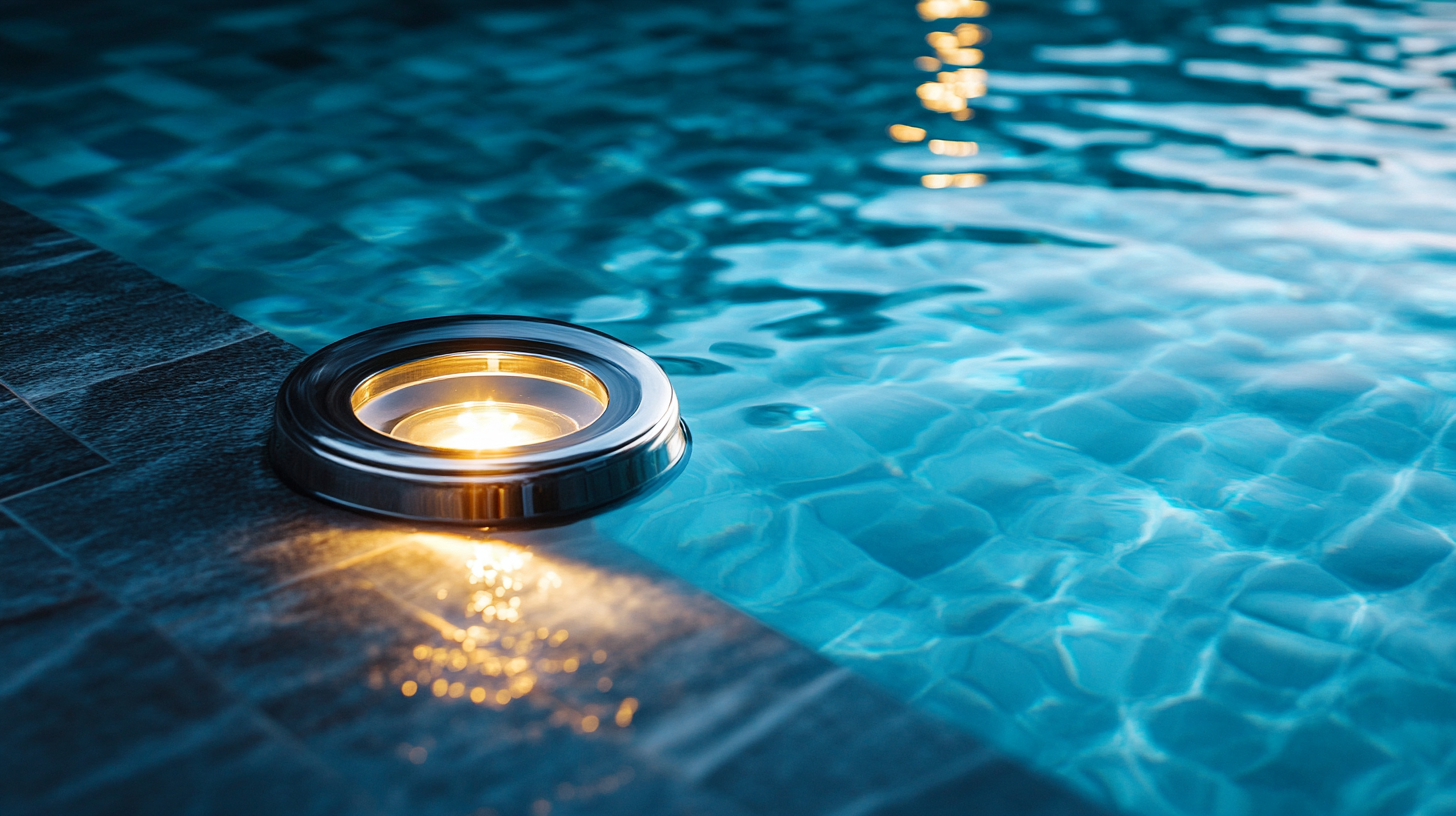The pros and cons of solar-powered underwater boat lights
Solar-powered underwater lights are an ingenious solution for adding illumination to your boat without the hassle of complex wiring or high energy costs. They work by harnessing sunlight with solar panels typically installed on your boat’s deck or some other unobstructed location. These panels capture energy during the day and store it in rechargeable batteries. Once the sun sets, the system automatically channels that stored energy to power the underwater lights installed at the hull of your boat. This seamless transition allows for a simple yet effective way to illuminate the waters beneath your boat.
Here’s where things get even more interesting: since solar-powered lights rely on renewable energy from the sun, they come with the added benefit of not increasing your energy bill, unlike traditional systems that use electricity from your boat’s battery or an external power source. The built-in batteries in most solar-powered systems are designed to store enough energy to run the lights all night long, making them especially convenient for nighttime dockings, fishing trips, or simply enjoying the shimmering magic beneath your boat.
What’s crucial to understand is that solar-powered underwater boat lights have autonomous controls which activate the lights as soon as dusk falls, so you don’t have to worry about manually switching them on and off. Just like with any technology, there are some pros and cons, which we’ll dive deeper into later in this article, but for now, you can appreciate how solar energy is conveniently harnessed to make underwater lighting easier and more environmentally friendly.
Benefits of using solar-powered lights for boats
Using solar-powered underwater lights on your boat brings several fantastic advantages that can make your time on the water both more enjoyable and eco-friendly. For starters, one clear benefit is the cost savings. Traditional underwater lighting systems often rely on power from your boat’s battery or require external energy sources, running up costs either in your electricity bill or fuel consumption. Solar-powered boat lights, on the other hand, harness free energy from the sun, which means there’s no added electricity expense. Once installed, solar systems practically run themselves, saving you from worrying about plugging into power sources or draining your battery.
In addition to being light on your wallet, switching to solar is undoubtedly kinder to the environment. These lights utilize renewable energy, which means you’re reducing your carbon footprint without compromising on performance or style. By opting for solar-powered underwater lighting, you’re effectively contributing to the broader movement towards green boating. For eco-conscious boaters, knowing that their dazzling underwater lights aren’t powered by fossil fuels is a huge plus.
Beyond the environmental feel-good factor, practicality is key here too. With automatic on/off sensors to detect when dusk arrives, solar-powered boat lights take the hassle out of remembering to flip a switch. This feature is especially useful for busy boaters who might forget to turn their lights on before a nighttime fishing session or cruise. Once the sun goes down, your underwater lighting instantly comes to life — no additional effort needed. This convenience adds a layer of security as well, as you won’t accidentally leave your boat in the dark when docking at night.
And let’s not forget about the longevity and durability of these systems. Solar-powered boat lights typically come equipped with weather-resistant materials designed to withstand the harsh marine environment. This means they’re built to last, even in saltwater conditions, reducing the need for frequent replacements or maintenance. Unlike standard electric systems, which are prone to corrosion or wiring issues, you’ll often find that solar-powered lights provide much better durability and reliability over time.
Another often overlooked benefit of using solar-powered lights on your boat is portability. Because these systems don’t require wiring to a central power source, they can be easily relocated or adjusted. If you decide you need to reposition your lights for a better effect or find that a new setup works better, you can achieve this with minimal effort. This flexibility is great for boaters who like to experiment with different underwater lighting layouts.
These lights also have a unique ability to enhance the overall aesthetic of your boat by casting an enchanting glow into the water. Whether you’re docked at a marina or cruising slowly along a tranquil bay, the brilliant display underwater will undoubtedly catch the eye. Solar-powered systems can also come in a variety of colors, allowing you to further customize the mood and ambiance, making your underwater world just as captivating as the one above deck.
Common drawbacks and limitations
While solar-powered underwater lights for boats come with numerous advantages, they aren’t without their drawbacks and limitations. One of the most significant issues boat owners might encounter is the inconsistency in power generation due to weather conditions. Since these systems rely on sunlight to charge their batteries, cloudy or rainy days can drastically reduce the amount of energy stored. This means that if you experience multiple sunless days, your underwater lighting may not last through the night or might not function at all until the batteries are sufficiently recharged. Boaters in areas with limited sunshine may find that solar-powered lights don’t perform as consistently as they would like, especially during winter months or in regions with frequent inclement weather.
Another consideration is the upfront cost of a high-quality solar lighting system. Although the long-term savings can outweigh the initial investment, the initial price tag for more durable, efficient models can sometimes be higher than electric alternatives. Budget-friendly solar boat lights may not have the longevity or brightness you expect, meaning they could need replacing sooner than initially planned. Therefore, the initial cost-benefit analysis requires careful consideration—while solar can save money in the long run by eliminating energy costs, it’s essential to weigh this against how long the lights will truly last in the marine environment.
Brightness is another potential limitation. Solar-powered boat lights often don’t match the sheer luminescence or power of traditional electric systems. Electric lights typically have a higher wattage capacity, meaning they can emit a brighter and often more consistent glow. For boaters who desire extremely bright underwater lighting—perhaps for fishing or attracting marine life—solar-powered options might fall short. While advancements are continually being made in the efficiency of solar technology, a solar system may still struggle to deliver the same level of intensity, especially when the batteries haven’t been fully charged during a lackluster day of sunlight.
Battery lifespan and capacity can also be areas of concern. While many solar-powered underwater light systems are designed to last throughout a typical night, especially after a full day in the sun, battery degradation over time is inevitable, and the performance of the lights may decline as a result. After repeated cycles of charging and discharging, the battery’s ability to hold a charge may reduce, necessitating a replacement sooner than expected. Furthermore, the performance of the system can be compromised if the batteries or solar panels aren’t maintained properly. Dust, salt, and grime buildup on solar panels can reduce their efficiency, slowing energy accumulation and thereby limiting the performance of the whole system.
Installation may be more restrictive than with electric systems. Because solar-powered lights require direct sunlight, the placement of the solar panels is crucial, and not all boaters have the luxury of extensive deck space free from obstructions. Panels need to be installed in areas where they have maximum sun exposure, and any shading from sails, masts, or canopy parts can hinder their charging capability. This can be especially challenging if you’re dealing with a smaller boat or a vessel where available space is at a premium. In contrast, electric lights simply need a power source, allowing much more flexibility in terms of positioning.
Comparing solar vs electric underwater boat lights
When comparing solar-powered underwater boat lights with traditional electric lighting systems, several key factors come into play that can influence a boater’s decision. Both options have their unique advantages and limitations, so it’s essential to closely evaluate how each type aligns with your needs and boating habits.
To start, solar-powered lights draw energy from sunlight using onboard solar panels, while electric systems rely on power from your boat’s battery or an external electrical source. The core difference here is the energy source, which directly impacts both sustainability and long-term costs. Solar-powered lights operate almost entirely on renewable energy, making them a more eco-friendly choice. Since solar panels convert sunlight into electricity, there’s no need to continuously tap into fossil-fuel-generated power, reducing both your environmental footprint and operational costs. Electric lights, however, place a direct strain on your boat’s battery or fuel resources, which could lead to higher ongoing expenses over time, particularly if you use your boat frequently or for extended night-time activities.
Another factor to consider is installation flexibility. Electric underwater lighting systems can be somewhat easier to install in terms of placement. Because their main requirement is simply to be connected to a power source, these lights can be installed at various locations on your boat without worrying about access to sunlight. Solar-powered lights, conversely, require clear access to sunlight to function effectively. This means you’ll need to allocate adequate space on your boat’s deck or hull for the solar panels. Shadows from sails, masts, or other structures can impact their performance, making the placement process more restrictive. For larger boats, this might not be an issue as there’s often more room to affix panels strategically. Smaller vessels with limited deck space could find this a bigger challenge, as optimal positioning for maximum sunlight might not always be available.
In terms of brightness and performance, electric lights typically outperform solar-powered models. Electric lights usually feature higher wattage and are capable of producing extremely bright, focused beams that can penetrate deep into the water—a feature that fishermen and sport divers might prefer. For those looking to create the most visible underwater lighting display, electric solutions often deliver more consistent luminescence. Solar-powered lights, in contrast, rely on battery-stored energy, which might not provide the same level of brightness, especially if the solar panels haven’t been exposed to sufficient sunlight during the day. Although solar-powered lights have improved significantly in recent years, they often fall short when compared to electric systems designed for maximum brightness.
Here’s a basic comparison table outlining some of the key differences between solar-powered lights and traditional electric lights:
| Feature | Solar-Powered Lights | Electric Lights |
|---|---|---|
| Energy Source | Renewable solar energy, free to operate after installation | Powered by onboard battery or external electrical supply |
| Initial Setup Cost | Higher upfront, long-term savings from free energy use | Lower upfront costs for simple systems, but higher energy usage over time |
| Brightness | Moderate brightness; depends on sunlight and battery charge | Higher brightness potential with continuous and strong light output |
| Maintenance | Low, but panels need occasional cleaning; batteries may degrade | Wiring, bulbs, and battery may require more frequent maintenance |
| Environmental Impact | Minimal; utilizes solar energy and reduces carbon footprint | Higher due to fuel or electricity consumption |
| Operational Range | Limited by battery capacity and sunlight availability | Unlimited as long as there is a reliable power source |
| Installation Flexibility | Restricted due to need for sunlight; panels must be placed carefully | More flexible as it requires only a connection to a power source |
Considering the cost factor, it’s important to distinguish between upfront investment and long-term operating expenses. Solar-powered systems might carry a higher initial installation fee due to the need for solar panels capable of storing sufficient energy. However, after installation, the energy costs are virtually non-existent because they rely on the sun for power. Over time, this makes them a more budget-friendly choice if you plan heavy use, as you’re not continuously paying for electricity or the fuel that runs your boat’s injector so the engine can power the lamp. Traditional electric lights, on the other hand, typically have a lower starting cost when it comes to equipment and installation because they don’t require solar panels. However, you’ll likely face increased costs over time due to higher energy consumption, particularly if your electrical system is not optimized for energy efficiency.
Durability is also a significant aspect to consider when weighing your options. Solar-powered systems usually contain fewer movable or mechanical parts, making them more resistant to wear and tear. Electric systems that rely on traditional wiring and connections can sometimes succumb to the harsh marine environment, resulting in more frequent maintenance. However, modern electric underwater lights designed specifically for marine use have become better at withstanding issues like corrosion.
In summary, while solar-powered underwater lights provide greater sustainability and long-term savings, they may not be the optimal choice for those needing maximum brightness and reliability in less sunny environments. On the other hand, electric lights offer superior brightness and flexibility in terms of installation but come at the cost of higher energy use and potentially more frequent maintenance requirements.
Choosing the right solar-powered light system
Choosing the right solar-powered light system for your boat can feel like navigating a sea of options, but with the right considerations, it doesn’t have to be overwhelming. The first thing to determine is what you actually need the lights for: are they purely for aesthetic purposes, or do they serve more functional roles in night-time visibility and safety? For some, a soft glow under the water is all that’s required to create an inviting ambiance during dockside gatherings, while others may be more invested in lights that allow them to spot fish or navigate tricky waters better. Recognizing these needs will guide you toward whether you need more powerful lights or can get by with mid-level brightness.
One of the top priorities when choosing solar-powered underwater boat lights is their brightness level. Since solar systems can be less powerful than traditional electric options, it’s essential to check the lumens rating of any models you’re considering. A lower lumen count may produce a softer glow, suitable for casual or decorative lighting, while a higher lumen system will deliver a more potent illumination that is practical for navigating or for fishing-related activities. Be mindful, however, that with greater brightness comes a bigger energy demand, so make sure the solar panels are strong enough to support your lighting goals—especially after a cloudy day.
Another key aspect is the battery life and charging capacity. Opt for systems with high-quality rechargeable batteries that can store enough energy during daylight hours to power the lights for as long as you need them at night. If you often find yourself out on the water for extended periods after sunset, choosing a system with a larger battery capacity is crucial. Pay attention to how many hours the lights are rated to run on a full charge—some systems can offer up to 12 hours of continuous light, while others may only last 4-5 hours.
Durability is a must-have feature, especially for marine environments where water, salt, and rough weather can take a toll on equipment. Look for solar-powered underwater lights made with corrosion-resistant materials like stainless steel or marine-grade aluminum. Poor-quality materials may end up rusting or suffering damage over time, requiring more frequent replacements than you’d like. On the same note, check the product’s waterproof rating—systems with at least an IP68 rating are more resistant to prolonged underwater use, ensuring they can withstand the subtleties of saltwater exposure.
Ease of installation is also important. Some solar-powered lights are designed to be easily attached with minimal tools or experience, while others may require more advanced knowledge, particularly if you’re trying to conceal wiring or panels for a cleaner aesthetic. Many solar-powered lighting systems come in all-in-one units where the solar panel, battery, and light are encased together, making installation super straightforward, especially for smaller boats or users looking for a hassle-free process. Check to see if the setup instructions are user-friendly, especially if you’re not a seasoned boat techie.
Lastly, don’t overlook additional features like color options, automatic sensors, or programmable settings that can enhance your boating experience. Some solar-powered systems come with multicolor lights, letting you switch between hues depending on your mood or event, while others include automatic dusk-to-dawn sensors that turn the lights on and off without you lifting a finger. While such features may seem minor, they can add convenience and a personalized touch to your underwater lighting setup.
By carefully considering these factors—brightness, battery life, durability, ease of installation, and any special features—you’ll be well on your way to selecting the perfect solar-powered underwater light system for your boat. Remember, the right choice ultimately hinges on how you plan to use the lights and what’s most important for your time on the water.


